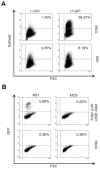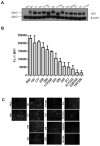Abrogation of TLR3 inhibition by discrete amino acid changes in the C-terminal half of the West Nile virus NS1 protein
- PMID: 24889229
- PMCID: PMC4044628
- DOI: 10.1016/j.virol.2014.03.017
Abrogation of TLR3 inhibition by discrete amino acid changes in the C-terminal half of the West Nile virus NS1 protein
Abstract
West Nile virus (WNV) is a mosquito-transmitted pathogen, which causes significant disease in humans. The innate immune system is a first-line defense against invading microorganism and many flaviviruses, including WNV, have evolved multifunctional proteins, which actively suppress its activation and antiviral actions. The WNV non-structural protein 1 (NS1) inhibits signal transduction originating from Toll-like receptor 3 (TLR3) and also critically contributes to virus genome replication. In this study we developed a novel FACS-based screen to attempt to separate these two functions. The individual amino acid changes P320S and M333V in NS1 restored TLR3 signaling in virus-infected HeLa cells. However, virus replication was also attenuated, suggesting that the two functions are not easily separated and may be contained within overlapping domains. The residues we identified are completely conserved among several mosquito- and tick-borne flaviviruses, indicating that they are of biological importance to the virus.
Keywords: Flavivirus; Innate immunity; NS1; TLR3; West Nile virus.
Copyright © 2014 Elsevier Inc. All rights reserved.
Figures






Similar articles
-
West Nile virus nonstructural protein 1 inhibits TLR3 signal transduction.J Virol. 2008 Sep;82(17):8262-71. doi: 10.1128/JVI.00226-08. Epub 2008 Jun 18. J Virol. 2008. PMID: 18562533 Free PMC article.
-
Role of NS1 and TLR3 in Pathogenesis and Immunity of WNV.Viruses. 2019 Jul 3;11(7):603. doi: 10.3390/v11070603. Viruses. 2019. PMID: 31277274 Free PMC article.
-
West Nile Virus NS1 Antagonizes Interferon Beta Production by Targeting RIG-I and MDA5.J Virol. 2017 Aug 24;91(18):e02396-16. doi: 10.1128/JVI.02396-16. Print 2017 Sep 15. J Virol. 2017. PMID: 28659477 Free PMC article.
-
Innate immune escape by Dengue and West Nile viruses.Curr Opin Virol. 2016 Oct;20:119-128. doi: 10.1016/j.coviro.2016.09.013. Epub 2016 Oct 25. Curr Opin Virol. 2016. PMID: 27792906 Free PMC article. Review.
-
Replication cycle and molecular biology of the West Nile virus.Viruses. 2013 Dec 27;6(1):13-53. doi: 10.3390/v6010013. Viruses. 2013. PMID: 24378320 Free PMC article. Review.
Cited by
-
Structure-guided insights on the role of NS1 in flavivirus infection.Bioessays. 2015 May;37(5):489-94. doi: 10.1002/bies.201400182. Epub 2015 Mar 11. Bioessays. 2015. PMID: 25761098 Free PMC article.
-
Flaviviridae Nonstructural Proteins: The Role in Molecular Mechanisms of Triggering Inflammation.Viruses. 2022 Aug 18;14(8):1808. doi: 10.3390/v14081808. Viruses. 2022. PMID: 36016430 Free PMC article. Review.
-
West Nile Virus Temperature Sensitivity and Avian Virulence Are Modulated by NS1-2B Polymorphisms.PLoS Negl Trop Dis. 2016 Aug 22;10(8):e0004938. doi: 10.1371/journal.pntd.0004938. eCollection 2016 Aug. PLoS Negl Trop Dis. 2016. PMID: 27548738 Free PMC article.
-
Secreted NS1 proteins of tick-borne encephalitis virus and West Nile virus block dendritic cell activation and effector functions.Microbiol Spectr. 2023 Sep 14;11(5):e0219223. doi: 10.1128/spectrum.02192-23. Online ahead of print. Microbiol Spectr. 2023. PMID: 37707204 Free PMC article.
-
Dengue virus NS1 enhances viral replication and pro-inflammatory cytokine production in human dendritic cells.Virology. 2016 Sep;496:227-236. doi: 10.1016/j.virol.2016.06.008. Epub 2016 Jun 24. Virology. 2016. PMID: 27348054 Free PMC article.
References
-
- Alcon-LePoder S, Drouet MT, Roux P, Frenkiel MP, Arborio M, Durand-Schneider AM, Maurice M, Le Blanc I, Gruenberg J, Flamand M. The secreted form of dengue virus nonstructural protein NS1 is endocytosed by hepatocytes and accumulates in late endosomes: implications for viral infectivity. J Virol. 2005;79(17):11403–11. - PMC - PubMed
Publication types
MeSH terms
Substances
Grants and funding
LinkOut - more resources
Full Text Sources
Other Literature Sources
Molecular Biology Databases
Research Materials

